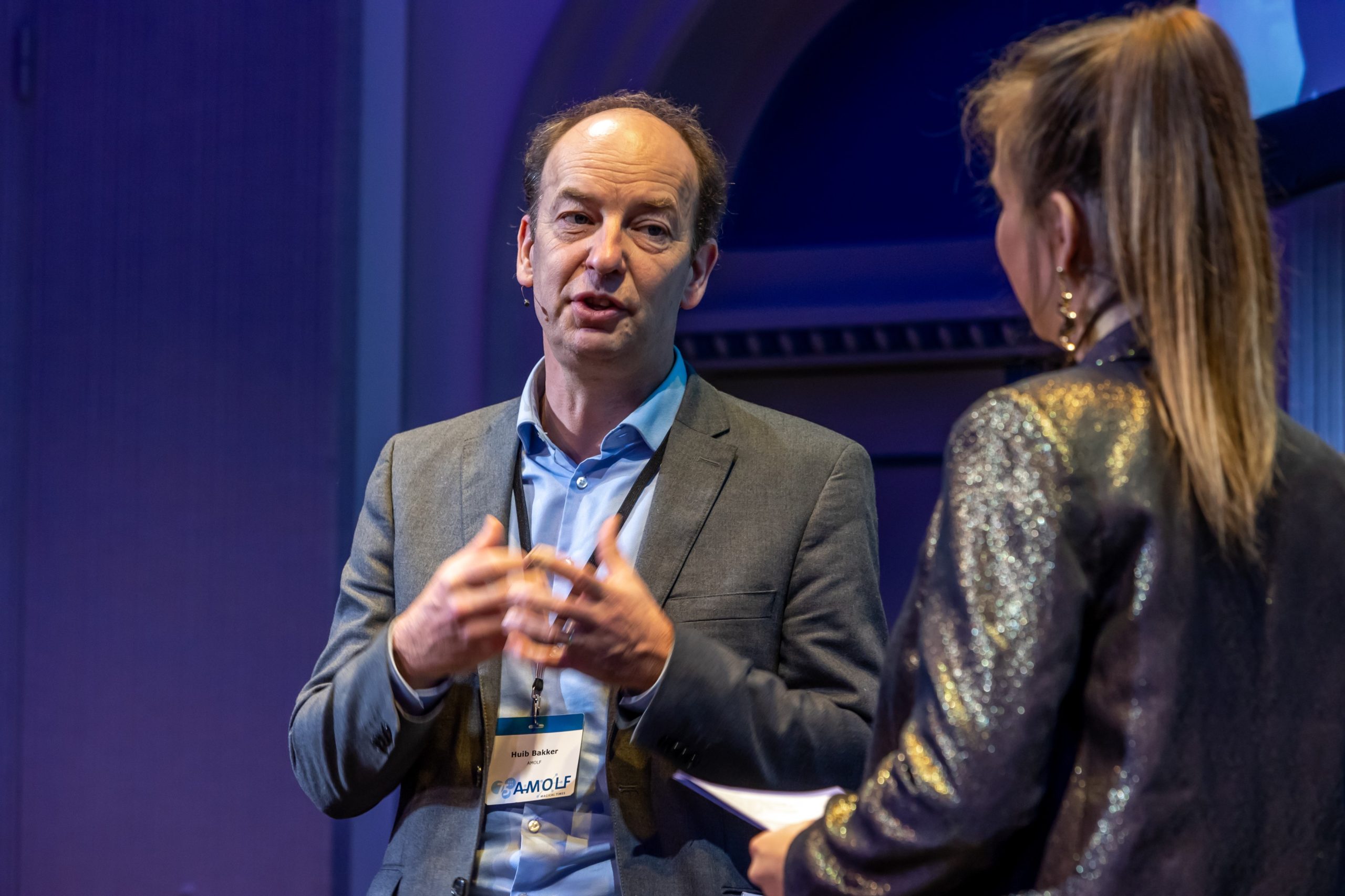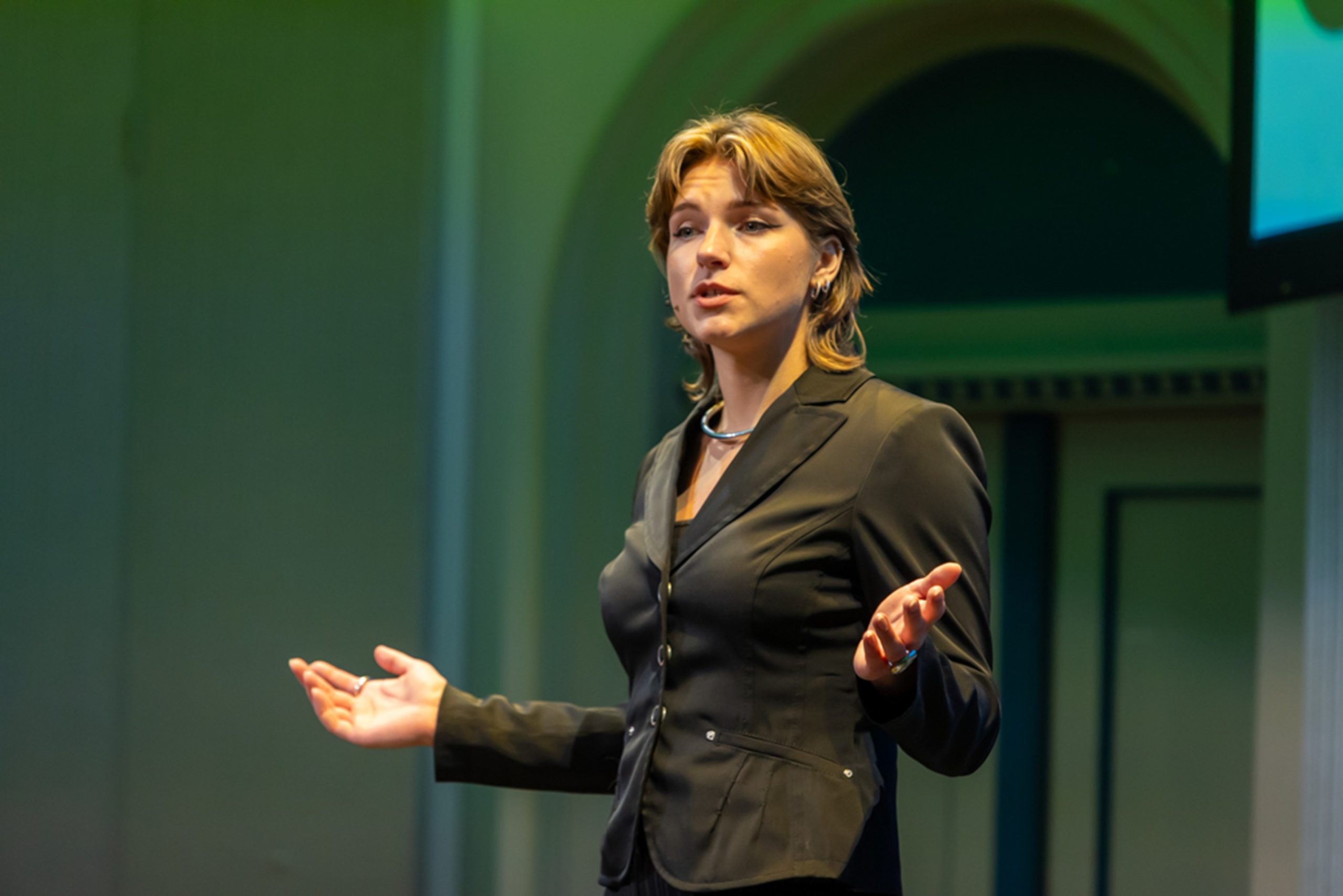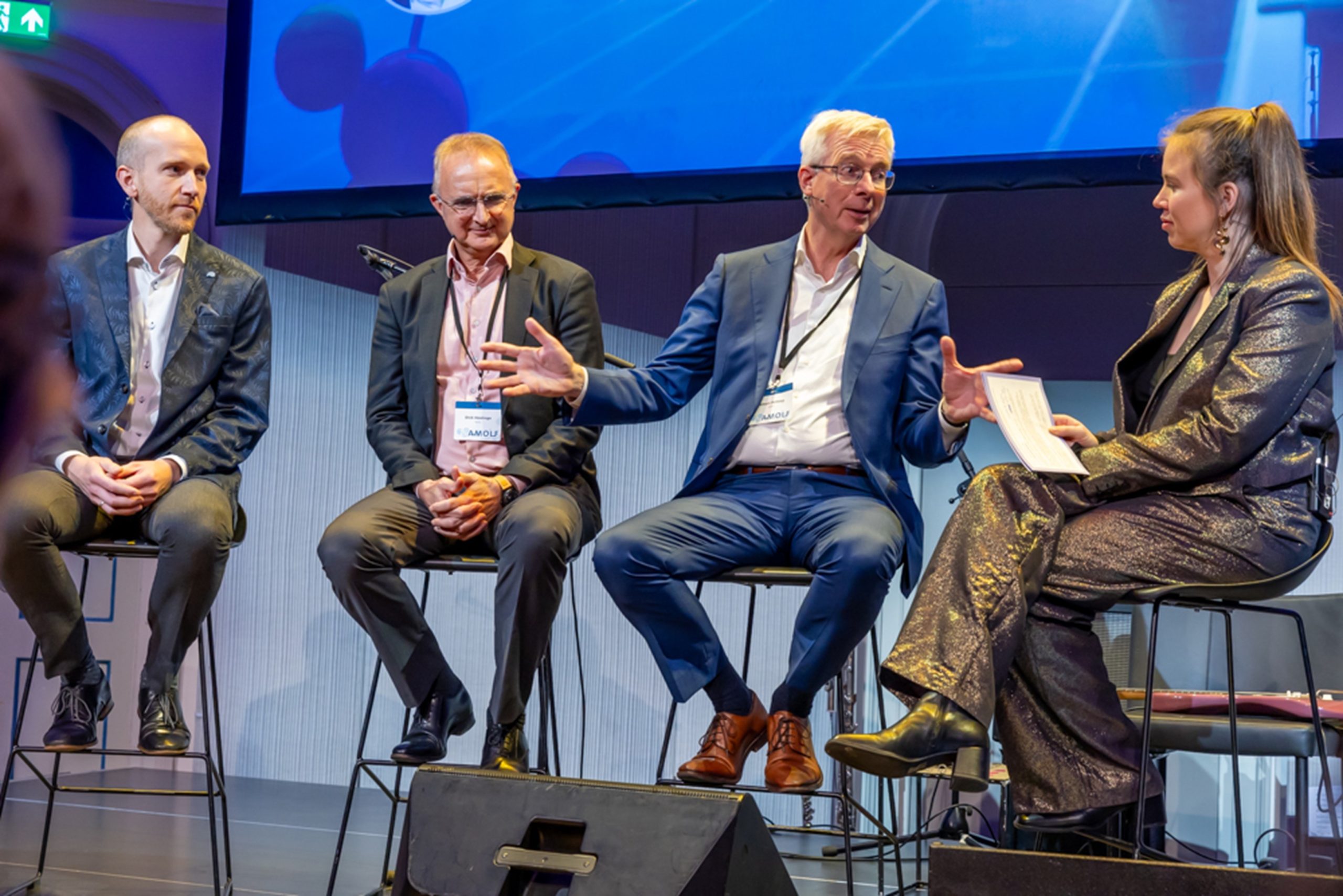AMOLF celebrates 75 years of magical times with network members
On November 12, AMOLF celebrated its 75th anniversary with its network partners at the iconic Felix Meritis in Amsterdam. The celebration drew together a diverse crowd of research collaborators, industry partners, policymakers, AMOLF staff and other esteemed relations. This gathering provided an opportunity to reflect on the institute’s achievements, and exchange ideas about its evolving role in the future of science and technology.
In this article, we share some highlights from the event. More in-depth news items on presentations and interviews given during this event, will follow later.
A community united by science

Chair of the day Yvonne Smit opened the afternoon program. She highlighted how this celebration, part of a series of events marking AMOLF’s 75th anniversary, was uniquely dedicated to engaging with external partners and collaborators. “AMOLF’s research has always thrived on collaboration,” Smit said. “Today, we celebrate not just our past, but the enduring connections that shape our research and impact.”
‘Solving societal issues with fundamental science’, an interview with Huib Bakker

AMOLF Director Huib Bakker took the stage to recount the institute’s evolution and the pivotal role of fundamental science in tackling societal challenges. He shared insights into AMOLF’s adaptability, its research philosophy, and its vision for the future. “We have a long tradition of reinventing ourselves,” he said, highlighting how AMOLF’s research programs have continually pivoted to address emerging scientific frontiers.
Bakker spoke passionately about the essence of AMOLF’s culture: ‘betrokkenheid’. “Our unique collaborative atmosphere fosters an environment where creativity and breakthrough discoveries are possible,” he said. The phrase “the magic of AMOLF” captures this intangible quality that has sustained the institute’s innovation for 75 years. When asked to look ahead, Bakker said: “We cannot predict where science will take us. The breakthroughs of today, like our work in quantum and soft matter physics, were unimaginable decades ago. So what we will do in 30 years will be different, but the spirit of exploration and curiosity that defines us will remain the same.”
‘Innovation needs bright minds’, an interview with Marcel Levi

Marcel Levi, President of the Dutch Research Council (NWO), shared his admiration for AMOLF’s enduring influence on the scientific landscape. “AMOLF is a prototype institute in terms of being innovative and collaborative”, Levi said. “It is also a nursery for new research lines, which then get transferred to universities and thus create space for new research.” He discussed AMOLF’s interdisciplinary approach that bridges traditional boundaries between physics, chemistry, biology, and materials science. “This is what makes AMOLF stand out: its ability to translate fundamental physics into real-world applications, impacting a variety of societal challenges from medical technology to renewable energy.” Levi concluded addressing the future of research funding in the Netherlands: “To remain at the forefront of global science, we must ensure stable and robust funding for fundamental research, which is the bedrock of technological advancement.” Despite challenges, Levi expressed optimism, pointing out that physics has consistently shown the ability to adapt, regenerate, and drive progress.
The future – research pitches of AMOLF’s rising stars
A highlight of the afternoon was a series of research pitches, presented by talented PhD students from AMOLF: Sarah Gillespie, Evan Usher, Masha Ogienko, and Daphne Antony. Each researcher shared his or her visionary work, illustrating how AMOLF’s focus on fundamental science can address real-world challenges and drive meaningful societal progress. These brief yet powerful talks showcase the cutting-edge research that defines AMOLF’s future.

Sarah Gillespie captivated the audience with her presentation on perovskite solar cells. She detailed how these materials could revolutionize solar energy by offering higher efficiency, flexibility, and lower production costs. “Sunlight is the planet’s most viable and redundant energy resource. We just need something to better convert it to electricity. After years of developing, we have reached limits in how much energy we can extract from traditional solar panels. That’s where perovskite solar cells come in. When combined with silicon, these can produce 50% more energy than current panels. Our research is paving the way for a more sustainable future.”

Evan Usher presented his research in biological physics, on bacterial information processing. “As a child, I often lay awake, overwhelmed by the vastness of the universe and the millions of stars suspended in an infinite void. This sense of anxiety followed me into adulthood, until I encountered a piece of artwork by David Goodsell, depicting the intricate inner workings of a bacterium. I became fascinated by how cells handle entropy, a measure of disorder. While cells cannot function in a state of high entropy, they’ve learned to harness the inevitability of its change, using chaos to sustain life. My PhD research focuses on understanding these information processes, revealing how bacterial cells manage the unpredictable and turn disorder into function.”

Masha Ogienko discussed her work on metasurfaces designed for the next generation of optical inspection techniques used in microchip manufacturing. Her collaboration with industrial partners aims to advance semiconductor technology, which is crucial for everything from consumer electronics to high-performance computing. Masha: “I work together with ARCNL – the research institute around the corner from AMOLF – and ASML – the company that develops technology for chip fabrication. Ultimately, we hope that metasurfaces will redefine metrology; that we will be able to detect fabrication errors without having to wait until the very end, making everything much faster, cheaper, and more reliable. And it will make chip manufacturer’s lives much easier.”

Daphne Antony grew up in a fishing village in South India, where her curiosity about the world around her began to grow. When a tsunami washed over the coast, she realized that the world was facing a climate crisis, and the rising sea levels terrified her. Since then, she has been committed to finding cleaner ways to generate electricity. She delivered a passionate pitch on electrochemistry for clean energy storage, with her research focusing on developing materials for a more efficient and sustainable energy storage system – critical for the global energy transition. “As a child, I had my fears, but I also had hope. I wish we could transfer hope, not fear, to today’s children,” she concluded, earning enthusiastic applause.
These research pitches were not just demonstrations of innovative and impactful science, but also reflections of AMOLF’s mission to train a new generation of scientists who think boldly and creatively. The sessions left a lasting impression on the audience.
‘How fundamental research contributes to life saving applications’, an interview with Kristina Ganzinger and Linde Meyaard
AMOLF group leader Kristina Ganzinger and UMC Utrecht Professor Linde Meyaard shared their joint work on understanding inhibitory immune receptors, a project that exemplifies AMOLF’s interdisciplinary approach. Their collaboration will lead to new insights into immune responses with the potential to inform cancer therapies and treatments for autoimmune diseases.

Meyaard: “10 years ago the field changed when it was discovered that when you block immune receptors, you can have the immune system fight cancer; you fight cancer by taking away the break. The field I was working on exploded through this discovery. We still discover new receptors and how they work, but we also try to apply this to disease treatment. Ganzinger stressed the importance of fundamental research as the foundation for medical innovation: “A biophysical approach helps us understand cellular processes at an unprecedented level, opening the door to transformative applications.”
‘How AMOLF collaborates and what works well – the example of SolarNL’
The event also featured a panel discussion on SolarNL, a major initiative of Dutch solar technology companies, research institutions, and academic partners, all working together to combat climate change through solar energy innovation. This collaborative effort was funded by the National Growth Fund. It is set to fast-track the Netherlands towards achieving its climate goals by 2050, aiming for climate neutrality with a production volume target of over 7 GWp/year of innovative solar cells and panels.

Albert Polman (Group Leader at AMOLF and Chair of SolarNL), Bruno Ehrler (Sustainable Energy Materials Leader at AMOLF) and Dick Heslinga (Director Strategic Marketing Industrialisation, CEA Grenoble) outlined how SolarNL exemplifies successful partnerships between academia and industry. They discussed the project’s strategic approach to bringing research from the lab to market, thereby accelerating the energy transition. “SolarNL represents a roadmap for how scientific research and industrial development can co-evolve,” Polman noted, emphasizing that such partnerships are essential for impactful, scalable solutions.
Closing reflections: science as a catalyst for connection and progress
As the event drew to a close, attendees continued the conversation over refreshments. The event underscored that, while the specifics of scientific challenges may change, the institute’s core values – collaboration, curiosity, and ‘betrokkenheid’ – will continue to drive its impact in the years to come.
Stay updated
Do you want to stay connected? Follow us on LinkedIn and subscribe to our online news magazine.
Photography: Liesbeth Dingemans


